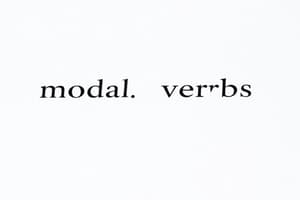Podcast
Questions and Answers
Which of the following is NOT a primary function expressed by modal verbs?
Which of the following is NOT a primary function expressed by modal verbs?
- Expressing ability
- Showing necessity
- Indicating past tense (correct)
- Granting permission
Modal verbs change form depending on the subject of the sentence.
Modal verbs change form depending on the subject of the sentence.
False (B)
What form of the main verb typically follows a modal verb?
What form of the main verb typically follows a modal verb?
infinitive without to
You __________ try the lasagna; it's delicious.
You __________ try the lasagna; it's delicious.
Match the modal verb with its most typical function:
Match the modal verb with its most typical function:
Flashcards
What are modal verbs?
What are modal verbs?
Auxiliary verbs expressing possibility, ability, necessity, or permission.
Common Modal Verbs
Common Modal Verbs
Can, may, might, could, should, would, will, and must.
Modal Verb + Main Verb
Modal Verb + Main Verb
They are followed by the main verb's infinitive (without 'to').
Modal Verbs in Past Contexts
Modal Verbs in Past Contexts
Signup and view all the flashcards
Uses of Modal Verbs
Uses of Modal Verbs
Signup and view all the flashcards
Study Notes
- Modal verbs are auxiliary verbs that express conditions like possibility, ability, necessity, and permission.
- Common modal verbs: can, may, might, could, should, would, will, and must.
- Less common modal verbs: shall and ought.
- Modal verbs are followed by the main verb’s infinitive (without "to").
- Modal verbs remain consistent across subjects.
- In past contexts, could, might, should, and would indicate hypothetical or past scenarios.
- Modal verbs are used in questions, suggestions, and to describe habits.
Studying That Suits You
Use AI to generate personalized quizzes and flashcards to suit your learning preferences.




